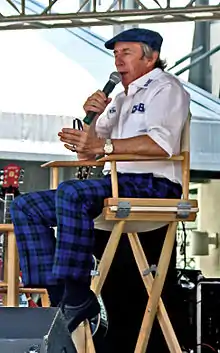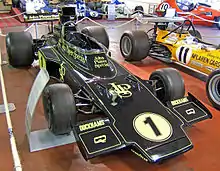1973 Formula One season
The 1973 Formula One season was the 27th season of FIA Formula One motor racing. It featured the 1973 World Championship of Drivers and the 1973 International Cup for F1 Manufacturers, which were contested concurrently over a fifteen-race series[1] that commenced on 28 January and ended on 7 October. There were two new races for the 1973 season – the Brazilian Grand Prix at Interlagos in São Paulo and the Swedish Grand Prix at Anderstorp. The season also included two non-championship races which were open to both Formula One and Formula 5000 cars.
| 1973 Formula One season | |||
| Drivers' Champion: Jackie Stewart Constructors' Champion: Lotus-Ford | |||
| Previous: | 1972 | Next: | 1974 |
The World Championship of Drivers was won by Jackie Stewart, driving for Elf Team Tyrrell, and the International Cup for F1 Manufacturers by John Player Team Lotus.[1] In the World Championship, Lotus teammates Emerson Fittipaldi and Ronnie Peterson raced each other while Stewart was supported at Tyrrell by François Cevert. Stewart took the Drivers' title at the Italian Grand Prix at Monza, but then at the final race of the season, the United States Grand Prix at Watkins Glen, Cevert crashed during Saturday practice in the notorious 'Esses' and was killed instantly. Stewart and Tyrrell withdrew from the race, handing the Manufacturers' title to Lotus. At the end of the season Stewart made public his decision to retire, a decision that had been made before the US Grand Prix. By the end of the 1973 season the best car on the track was probably the new McLaren M23, a wedge-shaped car following the same concept as the Lotus 72 but with more conventional suspension and up-to-date aerodynamics. The 1973 season marked the debut of future world champion James Hunt at the Monaco Grand Prix driving a privateer March 731 entered by Hesketh Racing.
The 1973 season saw the intervention of a Safety Car in Formula One for the first time, in the form of a Porsche 914 at the Canadian Grand Prix.[2] However, this safety concept would not be officially introduced until twenty years later, in 1993. As well as Cevert, Briton Roger Williamson was also killed during the season, in a crash at the Dutch Grand Prix at Zandvoort.
Another change to the rules introduced this season was the cars doing a full warm-up lap before the race. Prior to this, tracks included a dummy grid a short distance behind a grid proper, and the cars would simply move from one to the other to begin the race.
It was also this season that the numbering system for teams was formalised. In the second race of the season in Brazil, team-mates were paired - Lotus drivers 1 and 2; Tyrrell's 3 and 4 and so on - though the numbers assigned to each team still changed for a couple of races until the fifth race, the Belgian Grand Prix, at which the order was set for the rest of the season. For 1974, the numbers were assigned based on finishing positions in the 1973 constructor's championship, after which teams did not change numbers unless they won the drivers' championship (or signed the current world champion), or if a team dropped out.

Drivers and constructors
The following teams and drivers contested the 1973 World Championship.
-1.jpg.webp)

Grands Prix
The following races counted towards both the 1973 World Championship of Drivers and the 1973 International Cup for F1 Manufacturers.
Calendar changes
- The Belgian Grand Prix also carried the title of European Grand Prix for 1973.[3]
- After being absent from the Championship in 1972 due to extensive safety upgrades to the Zandvoort circuit including new asphalt, new barriers and a new race control tower, the Dutch Grand Prix returned to the Championship calendar for 1973.
Results and standings
World Championship of Drivers – final standings
Points were awarded on a 9–6–4–3–2–1 basis to the first six finishers in each race.[4] For classification, only the seven best results from the first eight races and the six best results from the last seven races were retained.[5] Drivers who scored an equal number of points were awarded equal championship classifications, regardless of the relative number of wins, second places, etc. scored by each driver. The FIA did not award a championship classification to those drivers who did not score points in the championship.[1]
|
| |||||||||||||||||||||||||||||||||||||||||||||||||||||||||||||||||||||||||||||||||||||||||||||||||||||||||||||||||||||||||||||||||||||||||||||||||||||||||||||||||||||||||||||||||||||||||||||||||||||||||||||||||||||||||||||||||||||||||||||||||||||||||||||||||||||||||||||||||||||||||||||||||||||||||||||||||||||||||||||||||||||||||||||||||||||||||||||||||||||||||||||||||||||||||||||||||||||||||||||||||||||||||||||||||||||||||||||||||||||||||||||||||||||||||||||||||||||||||||||||||||||||||||||||||||||||||||||||||||||||||||||||||||||||||||||||||||||||||||||||||||||||||||||||||||||||||||||||||||||||||||||||||||||||||||||||||||||||||||||||||||||||||||||||||||||||||||||||||||||||||||||||||||||||||||||||||||||||||||||||||||||||||||||||||||||||||||||||||||||||||||||||||||||||||||||||||||||||||||||||||||||||||||||||||||||||||||||||||||||||||||||||||||||||||||||||||
† Cevert suffered a fatal accident in qualifying for the United States Grand Prix.
International Cup for F1 Manufacturers – final standings
Points were awarded on a 9–6–4–3–2–1 basis to the first six finishers in each race.[4] Points were only awarded for the position filled by the best placed car from each manufacturer.[6] For classification, only the seven best results from the first eight races and the six best results from the last seven races were retained, Points in the table outside of the parentheses are the points which contributed to the Championship, points within parentheses show the total points scored.[5]
| Pos. | Manufacturer | ARG |
BRA |
RSA |
ESP |
BEL |
MON |
SWE |
FRA |
GBR |
NED |
GER |
AUT |
ITA |
CAN |
USA |
Pts. |
|---|---|---|---|---|---|---|---|---|---|---|---|---|---|---|---|---|---|
| 1 | 1 | 1 | 3 | 1 | (3) | 2 | 2 | 1 | 2 | 11 | 6 | 1 | 1 | 2 | 1 | 92 (96) | |
| 2 | 2 | 2 | 1 | 2 | 1 | 1 | (3) | 2 | 5 | 1 | 1 | 2 | 4 | 5 | DNS | 82 (86) | |
| 3 | 5 | 3 | 2 | 4 | 7 | 5 | 1 | 8 | 1 | 4 | 3 | 8 | 3 | 1 | 4 | 58 | |
| 4 | 6 | 11 | 7 | 10 | 4 | 7 | 4 | 3 | 6 | Ret | 5 | 4 | 6 | 8 | 3 | 22 | |
| 5 | 10 | Ret | NC | 7 | 11 | 9 | 8 | 6 | 4 | 3 | 15 | Ret | 9 | 7 | 2 | 14 | |
| 6 | 4 | 4 | 4 | 12 | Ret | Ret | 6 | 5 | 8 | WD | WD | 7 | 8 | 15 | 16 | 12 | |
| 7 | 7 | 6 | Ret | 5 | 5 | Ret | 9 | 9 | 7 | 5 | Ret | 5 | 13 | 4 | 8 | 12 | |
| 8 | WD | 6 | 3 | 9 | 10 | 14 | 10 | Ret | 10 | 8 | Ret | 10 | 3 | 13 | 9 | ||
| 9 | Ret | 12 | 8 | Ret | 8 | 8 | 10 | 13 | Ret | 7 | 4 | 3 | 7 | 9 | Ret | 7 | |
| 10 | NC | 7 | 10 | 11 | Ret | Ret | 11 | 14 | 9 | 6 | 10 | 9 | NC | 6 | 7 | 2 | |
| 11 | 6 | Ret | WD | WD | Ret | Ret | WD | DNS | WD | 1 | |||||||
| — | WD | WD | WD | 15 | 13 | DNS | WD | Ret | Ret | NC | Ret | 0 | |||||
| Pos. | Manufacturer | ARG |
BRA |
RSA |
ESP |
BEL |
MON |
SWE |
FRA |
GBR |
NED |
GER |
AUT |
ITA |
CAN |
USA |
Pts. |
| Source:[8] | |||||||||||||||||
Ensign, which did not score points during the championship, was not given a classification in the official FIA results.[1]
Non-championship races
The 1973 Formula One season included two non-championship races which were open to both Formula One and Formula 5000 cars.[9][10]
| Race Name | Circuit | Date | Winning driver | Constructor | Report |
|---|---|---|---|---|---|
| Brands Hatch | 18 March | Report | |||
| Silverstone | 8 April | Report |
References
- Results of the 1973 FIA International Championships, 1974 FIA Yearbook, Grey Section, pages 104–105
- Kathri, Tarun (2012-02-07). "First ever Safety Car in Formula 1 : Rewind to 1973". aaFormula1.com. Archived from the original on 2015-04-07. Retrieved 2015-04-03.
- Peter Higham, The Guinness Guide to International Motor Racing, page 71
- Peter Higham, The Guinness Guide to International Motor Racing, page 6
- Automobile Year, 1973/74, page 236
- Peter Higham, The Guinness Guide to International Motor Racing, page 74
- Official FIA results, as published in the 1974 FIA Yearbook, Grey Section, page 105, awarded the 1973 International Cup for F1 Manufacturers to "John Player Special"
- "1973 – World Championship Result". StatsF1. Retrieved 23 January 2016.
- The B24, Powered by Chevrolet, Lost Marques: Chevron, www.uniquecarsandparts.com.au Retrieved on 3 May 2012
- It Never Rains, but it Snows: The 1973 BRDC International Trophy, themotorsportarchive.com Retrieved on 3 May 2012